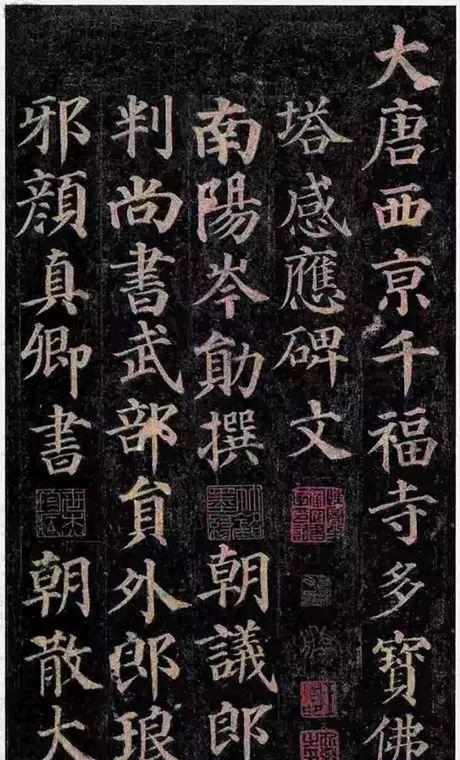The first stage: before the age of 50
During this period, Yan Zhenqing inherited the tradition, cast all things in pottery, and took Erwang, Suiliang, and Zhang Xu as his teachers, and his calligraphy was characterized by Qingxiong's tenacity. The representative works are "Duo Pagoda Stele" and "Oriental Shuo Painting Praise Monument".

Yan Zhenqing's "Many Pagoda Tablets" (partial)
"Duo Pagoda Stele" is the earliest stele that can be seen in Yan Zhenqing's heirloom works, which can represent the early style of Yan Shu. Yan Zhenqing, like most scholars and doctors in the Tang Dynasty, was an orthodox Confucian and also believed in Buddhism, so when writing this stele, he was naturally respectful and sincere.
As a famous work of Yan in the early days, the afterglow of the second king, Ou, Yu, and Chu, the whole article is strictly structured, there are silk railings between the lines, the dot painting is round, dignified and elegant, a stroke and a pinch appear to be quiet and moving, ethereal, and those who learn Yan are mostly handy from this monument.
Yan Zhenqing's "Oriental Shuo Painting Praise Monument" (partial)
The "Oriental Shuo Painting Praise Monument" is An early work of Yan Zhenqing, not the most representative handwriting in his life, but it was regarded as a gui table by the Song Dynasty all-rounder Su Dongpo. If we compare Su Dongpo's font slightly, we will understand the reason. Su Shi and Yan Zhenqing's aesthetics are consistent, and it is precisely in the imperfection and immaturity of Yan's monumental art that he found the opportunity to move towards a new peak.
This stele line is strong and strong, fangzheng junshuang, like a solemn and majestic hall, and the state of jianbu is like a mountain dominating one side, making people feel the artistic power of "yan body".
The second stage: 50-60 years old
This period is the period when Yan Zhenqing's calligraphy matured. The largest number of works from this period is now seen, with about 28 being seen. During this period, Yan Shina was new in the ancient law, officially walking out of the fence wall of the Second King to the early Tang Dynasty and creating a new Yan body. Representative works include "Qiyushu Release Pond Stele Table" (52 years old), "Xianyu Shi Lidui Record" (54 years old), "Guo Family Temple Stele" (56 years old) and so on.
Yan Zhenqing's "Records of the Fresh Yu Clan Leaving the Pile" (Partial)
"The Record of the Departure of the Xianyu Clan" is yan Zhenqing who, when he was demoted to the history of the governor of Pengzhou, passed through New Deal County on his way to his post, specially visited the local Noble Clan Xian Yu Zhongtong, and wrote this "Record of leaving the Pile" for the Xian Yu clan.
This stone carving is similar to the style of "Oriental Shuo Painting Praise Monument", majestic and clean, high and ancient, but with a more skilled pen, the italic style is becoming more and more distinct, and a loyal and righteous atmosphere jumps between the words.
Yan Zhenqing's "Guo Family Temple Monument" (partial)
"Guo Family Temple Stele" is majestic, the air and bones are flowing, and the dense and broad are integrated, reflecting yan Zhenqing's small changes in the style of writing. This inscription shows that the "Yan body" calligraphy is sent with the palm and wrist of the finger elbow; the hook painting and the stroke painting are suitable to form an artistic style with a wide body and a broad layout.
During this period, the political situation was changeable, people's hearts were turbulent, and Yan's life path was bumpy, so there were many lines of writing and rulers. Among them, the most famous inkblots are "Sacrifice Nephew Manuscript", "Liu Zhong's Envoy Post", "Battle for Seat Post" and so on.
Yan Zhenqing's Manuscript of the Sacrifice of the Nephew (Partial)
Among them, the "Sacrifice Nephew Manuscript" was Yan Zhenqing who wrote this draft of the sacrifice with the mood of "caressing and destroying and shocking the heart", and with blood and tears, to mourn the nephew Ji Ming who was brutally killed by the rebels.
This draft is based on sincere emotions, under the passion, regardless of clumsiness, unrestrained, arbitrary, distinctive personality, unique form, which is not available to predecessors.
The third stage: after the age of 60
This was the period when Yan Zhenqing's calligraphy art was at its peak. During this period, although Yan still held Confucian aspirations and was loyal to his duties, he had penetrated the world. Most of the spirit is placed between natural landscapes and calligraphic tastes, so more ink treasures are written than in the previous two periods. For example, "Magu Xiantan" (63 years old), "Ode to The Tang Dynasty Zhongxing" (63 years old), "Eight Guanzhai Hui Bao De Ji" (64 years old), "Right Xiang Song Jing Monument" (64 years old), "Yan Qinli Monument" (71 years old), "Yan Family Temple Monument" (72 years old) and so on.
The stele of "Magu XianTan" is the middle and late works of Yan Zhenqing, at this time, Yan body has achieved a second leap, from "work" to "no work", penmanship, structure adaptable, many words of the knot and pen almost ugly, and even unstable center of gravity, which is a pursuit of Lu Gongyi in simplicity.
The Magu Immortal Altar sacrifices life, the meaning is interesting, the miracle is difficult to seek, and it returns to simplicity, and the three of Confucianism, Taoism, and Shi are all shadowed in yan's personality and the inkblot of the "Magu Immortal Altar", which means endlessly.